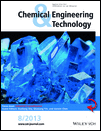Solution-Mediated Phase Transformation of a Hydrate to its Anhydrous Form of Donepezil Hydrochloride
Abstract
The solubility of form I (hydrate) and form III (anhydrous form) of donepezil hydrochloride (DHCl) in methanol/isopropyl ether mixtures was determined at different temperatures by a synthetic method with laser monitoring observation. The experimental data were correlated with the modified Apelblat equation. Dissolution enthalpy and entropy were predicted by this equation. The mechanisms involved in solution-mediated transformation of a hydrate (form I) to its anhydrous form (form III) was investigated and characterized by in situ and offline measurement technologies, such as focused-beam reflectance measurement (FBRM), powder X-ray diffraction (PXRD), differential scanning calorimetry analysis (DSC), and moisture analyzer. The transformation involves nucleation of the metastable solid (form I), dissolution of the metastable solid, self-recognition of the molecular units to nucleate a more stable solid phase (form III), and growth of the stable phase. The results indicate that the rate of transformation increases with increasing temperature and driving force.




